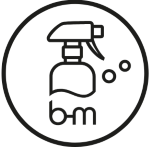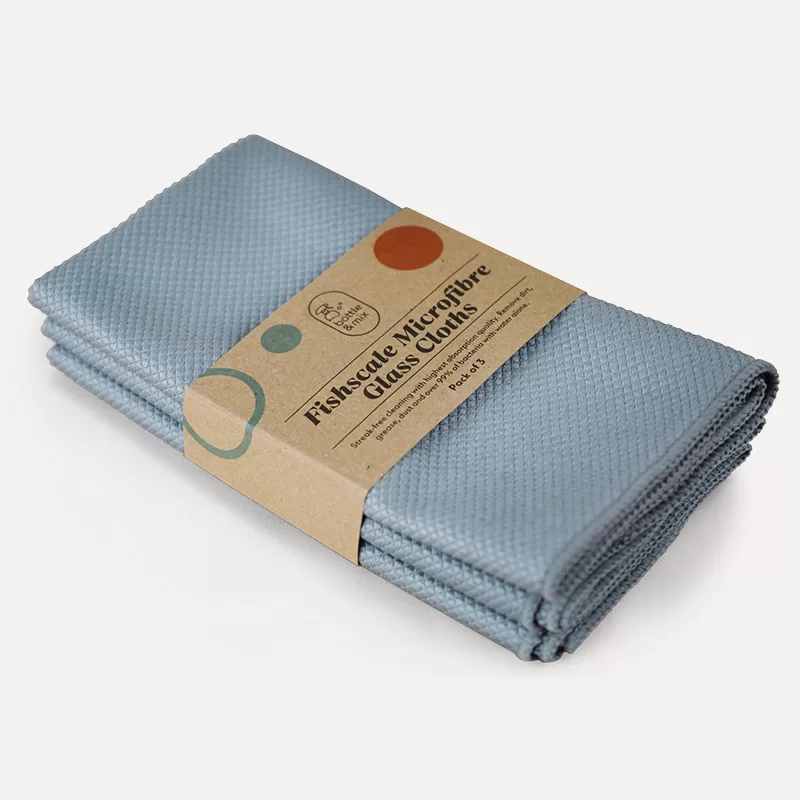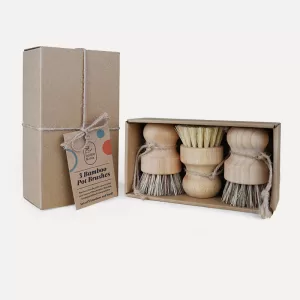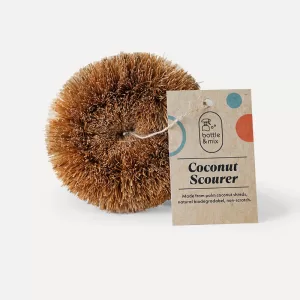With its aggressive weave, this cloth is perfect for cleaning grime and excels at polishing windows, glass, mirrors, and delicate surfaces.
 How to get streak-free glass:
How to get streak-free glass:
It’s all about having the right tools and using the best techniques:
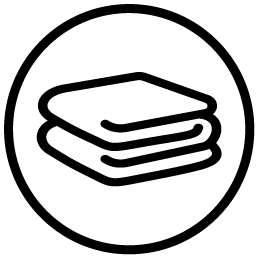 Method 1: Use the Microfibre Glass Cloth dry
Method 1: Use the Microfibre Glass Cloth dry
Start with a fresh, dry Microfibre Glass Cloth. In many situations, a quick buff is all you need. Just use gentle, swift motions across the surface of your table, mirror, or window. The best part? It’s done in seconds, and you won’t need any additional cleaning products!
 Method 2: Use the Microfibre Glass Cloth with a cleaning solution
Method 2: Use the Microfibre Glass Cloth with a cleaning solution
Start by preparing your cleaning solution: We suggest mixing 1 teaspoon of Castile Soap with 250 ml of distilled water. It’s better to use distilled water instead of tap water. Hard water, rich in minerals like magnesium and calcium, tends to leave a streaky residue when mixed with cleaners. Also using less cleaner is actually more effective.
Spray your cleaning solution directly onto your Microfibre Glass Cloth to prevent drips that might leave streaks if not wiped up quickly. Begin at the top of the window and work your way down to avoid any drips.
Any liquid left on the glass can cause streaks, so make sure to dry it completely after cleaning. Use a fresh, dry Microfibre Glass Cloth and wipe in long, straight motions from top to bottom. Fold the cloth a few times to create multiple dry sections. Continue wiping from edge to edge until the cloth has absorbed all the remaining water.
If you are left with a streak or two, just give it a swift buff, and you’ll have it looking perfect in no time!
Pro Tip 1:
Choose the right conditions to clean your windows. The rate at which your cleaning solution evaporates plays a significant role in achieving a streak-free result. If the solution dries too quickly, it can leave be-hind streaks. Clean your windows on a cloudy day or when they’re shaded. Additionally, opt for warm or cold water instead of hot.
Pro Tip 2:
If you have a dehumidifier, you can use the water to clean windows and floors – it’s almost mineral-free and will leave them streak-free!
Microfibre Cloths are great at trapping dust, dirt, and germs, but it’s important to clean them thoroughly after use to get rid of any debris stuck in the tiny fibres.

How to wash by hand:
To clean Microfibre Cloths, shake them outside or into a trash bag to remove dirt. Then, soak the cloths in cool or warm water for 15-20 minutes and gently rub them to release any grime. Rinse tho-roughly with running water, squeeze out excess water, and hang to dry.
 How to launder your Microfibre Cloths:
How to launder your Microfibre Cloths:
Although these cloths can be washed up to 95 degrees Celsius, we recommend washing them at a temperature of 40 degrees, which will be sufficient to clean them effectively. There may be some shrinkage in the initial washes, up to 5%. Wash Microfibre Cloths separately from other fabrics to prevent lint from sticking to them and reducing their effectiveness over time. When washing mixed loads, avoid washing with cotton and only use non-linting synthetic materials.
Only use regular laundry detergent or none at all. Don’t use oily or soap-based detergents and avoid fabric softeners, which can clog the fibres and reduce their effectiveness until washed out. Unlike many other Microfibre Cloths, these cloths can be tumble dried, which can be beneficial as it opens the fibres. They won‘t burn at high temperatures like most Microfibre Cloths. If you put Microfibre through the clothes dryer, make sure your filters are clean as the cloth will pick up all the lint. Alternatively, you may choose to air dry the cloths as they have a quick drying time.
If you wash and dry Microfibre properly (without fabric softener) and keep them in good condition, you’ll have them for many years to come. Microfibre just doesn’t wear out like traditional fabric.
